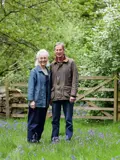Located over 140 acres of mixed terrain across the rolling hills of North Yorkshire, family run farm High Braythorne recently collaborated with Environment Bank to help diversify their income. Farmer Rupert Arnold and his wife Fiona had begun to realise that it was not only increasingly becoming more difficult to make a profit from a small farm, but that farming subsidies were changing and eventually ending. This made them sure that a change had to be made and after a lot of research, the couple contacted Environment Bank.
My wife Fiona and I had studied holistic farming and focussed on how we could increase biodiversity and lessen the heavy workload of our current farming system. This was to ensure we had options when we reached an age where we could not perform such physical work. We, along with our grown-up children spent nine months researching every avenue and realised we didn’t have the expertise of an ecologist or the funds to support what needed to be done. Environment Bank had the knowledge and the means to help us create a Habitat Bank on 32 of our 55 hectares of farmland, which would provide us with a new and long term revenue stream and create a more biologically diverse landscape.
Why did you choose Environment Bank's model?
The team of ecologists came to the farm and conducted a thorough assessment of the landscape to ecologically baseline it, before creating a management plan with us to design the new habitats within the sphere of the DEFRA Biodiversity Metric.
Leading on the management plan, ecologist Rob Wreglesworth fully assessed the land and collectively set aside 32 hectares for a Habitat Bank to connect the ancient woodland currently on the farm, maximising the environmental benefits.
The team has looked at the site's geology, soil chemistry, management history, hydrology and landscape connectivity to help to determine the best possible new habitats for the land, which is currently a mixture of permanent pasture and silage fields.
They assessed what vegetation and wildlife were currently present, and the quantity of woodland, ponds and hedgerow to include in the plan. Planting is starting this summer, working alongside our current sustainable farming incentive (SFI) pilot scheme, and the vision over the next 5-10 years is to have a farm with multiple revenue streams.
What is the process so far?
The recovery programme on the land will be fully established over the next 5-10 years leading to the creation of a more functional and resilient natural landscape capable of supporting richer and more abundant biodiversity.
The water run-off will also be reduced in as little as 10 years’ time, as flooding has become an issue due to the compacted ground on the land. This will result in better soil quality and a species-rich meadow which will be deeper rooted to improve soil structure and increase organic matter which will hold more water. Strategically placed ponds will also be created to slow the surface water flow, resulting in less erosion and better water quality in the catchment.
How will the land change?
By allowing nature to recover, we hope our Habitat Bank will offer a huge range of benefits to the local community. Some of these benefits include better air and water quality, locking up carbon, reduced flood risks, improved health and wellbeing and more nature-based economic opportunities. Also, by increasing biodiversity, it can help to increase food yield with an increased abundance of pollinators and improved soil health locally.
Contributing to the community is important to us, as well as enhancing the local landscape. By creating a Habitat Bank on the land, we can increase biodiversity, encourage wild species, and continue to work with other farmers as an integrated farm, meaning others can still use our land for livestock grazing if needed.
We also hope to also eventually use the Habitat Bank to gain accreditation for school visits for young people studying biodiversity. We hope to work with students to track the management plan and monitor the wildlife, linked to the national curriculum and college programmes.
What other benefits do you expect from creating a Habitat Bank?
If you want the certainty of the long-term nature of the funding, we found this model to be the best one, far surpassing anything else that was on offer from other schemes. The capital investment in terms of water supply to the Habitat Bank, hedges, fencing, and planting to restore the land would have cost us thousands to do ourselves, but by working with Environment Bank, we have access to funding, the expertise of the ecologists and a solid plan to manage the process for years to come.
What advice would you give to other farmers?
GET STARTED WITH HABITAT BANK CREATION
Find out the habitat options for your land and the income you could generate by registering your land or calling our team on 01904 202 990.





